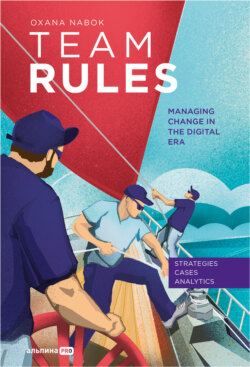Читать книгу Team Rules: Managing Change in the Digital Era - - Страница 4
01. STRATEGIC DIGITAL MANAGEMENT
Chapter 1. Transformational leadership in a new reality. Changing the evolution of leadership competencies
ОглавлениеWelcome to the world of rapid change! The concept of “stability” is no longer applicable to organizational management. Instead, the key priorities of transformational leadership involve the ongoing quest for growth opportunities to unleash the organization's potential, boost team productivity, and ensure the sustainability of services while implementing new processes and systems.
The success of modern organizations hinges on several key factors, including operational change management, innovative strategies, a corporate culture that embraces innovation and digital performance boosters, as well as the transformation of models and processes through team engagement. Notably, client-centric systems that address the requirements of both external clients (consumers) and internal ones (employees, partners, and all stakeholders of the organization) take center stage.
“
SERGEY CHUMAK, International Expert on Business Transformation and Strategy, Head of the Strategy Committee of the Digital Experts Association (DEA):
– Digital transformation is undoubtedly rooted in technology, but its primary focus is always on the client: creating value for the client involves a creative experiment that inherently carries an innovation risk. An update to organizational design is imperative, as it serves to stimulate creativity.
One of the most significant challenges encountered in the process of digital transformation is cultural transformation. The question that continues to puzzle many is how to motivate managers to be creative, responsible, and successful entrepreneurs within this context.
”
What about management?
Today, volatility, dynamism, and frequently the absence of clear benchmarks have become the new norm. While it may be described as harsh, it has acted as a catalyst for the next phase of evolution in management models.
Once upon a time, we transitioned from a division of labor to centralized management with a strict hierarchy. Nowadays, we are moving towards an innovative culture within organizations that have shorter structures and a minimal number of management layers where everyone has the potential to assume a leadership role, particularly within specific tasks and projects and where motivation is not only about dangling a carrot in front of employees but also ambitious goals, sustainable collaboration and smart competition (see Figure 1).
At the forefront is a focus on seeking common interests of clients, employees, partners, and all stakeholders to create a sustainable organizational ecosystem and unleash its potential through the integration of digital tools, thereby improving interaction efficiency. Even the most flawless strategy will fail if it lacks the support of the team. In this case, the dynamic and simultaneous introduction of innovations is replaced by a more rigid adherence to guidelines.
The team, much like a living organism, will either adapt to changes (ideally initiating them) or reject them as unnecessary while maintaining the existing status quo and a consensus that is currently favorable. The trend of involving employees, clients and partners in the development and enhancement of a strategy becomes a natural norm and paves the way for its successful implementation.
